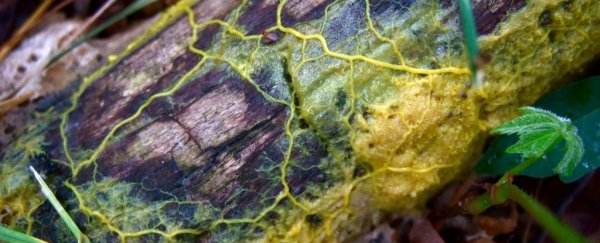Back in April 2016, French scientists rocked the neuroscience world when they found evidence that a brainless slime called Physarum polycephalum was learning to avoid unpleasant stimuli during repeated trials.
Now, a few months later, the team has shown that the 'informed' slime might actually be able to transfer this knowledge to a patch of naive slime by fusing with it. And that's pretty impressive, but it's just one of the weirdly incredible things about P. polycephalum.
While the slime looks like nothing more than an oozy patch of yellow, it's actually a colony of single-celled organisms more closely related to amoeba than actual fungal moulds. And these microscopic protozoan cells come together to form a much larger entity.
For this reason, the organism is commonly called the many-headed slime.
Most of the time, the slime can be found hanging out in wooded areas where it feeds on fungi, bacteria, and rotting matter. Oh, and it can move rather quickly for its size, travelling up to 4 centimetres (1.5 inches) per hour.
Though you wouldn't pay much attention to the slime when walking through the woods, researchers have been studying it a lot lately because – despite its looks – it might hold the key to understanding how our intelligence first evolved millions of years ago.
Earlier this year, researchers from Toulouse University in France discovered that the slime would remember to avoid unpleasant stimuli after experiencing it multiple times.
The team concocted a little obstacle course for the slime, which had patches of unpleasant things along the way, specifically spots that were laced with caffeine.
"At first, the slime disliked the caffeine-laced areas on the bridge and tried to avoid them, which was expected, because all living things will generally avoid sources of unpleasantness. The crazy part is that, after a few days, the slime got better and better at navigating the 'safe' areas of the bridge, showing that it learned from past expeditions and, therefore, held some form of basic intelligence."
Now, the team is back with further evidence to suggest that the slime could be sharing this knowledge with the rest of the slime puddle after it fuses together.
To come to that conclusion, the researchers broke out their trusty bridge experiment again, but this time, they took a 'naïve' sample, which had never learned to avoid the unpleasant bit of bridge, and an 'informed' - or habituated - sample that had already learnt the course, and let them fuse together.
They used salt as the obstacle this time instead of caffeine, and taught the habituted slime how to avoid it.
The team found that, even if they took three naïve samples and fused them with one habituated sample, the now-fused slime navigated the bridge as if it knew exactly where the obstacles were, though they note that it took a bit of time for that knowledge to work its way into the naïve parts of the organism.
"We show that a slime mould resulting from the fusion of a minority of habituated slime moulds and a majority of unhabituated ones still shows an adaptive response to the repellent," the team writes.
"Finally, we further reveal that fusion must last a certain time to ensure an effective transfer of the behavioural adaptation between slime moulds."
This hints that the naïve sample was quickly assimilated with the habituated sample and the knowledge that there is salt on the bridge was passed onto the newly fused single-celled organisms.
So what's going on here? How does any of this work if there isn't a brain involved? No one is 100 percent sure just yet, though Michael Levin from Tufts University, who wasn't involved in the research, says it might not be as strange as it sounds, suggesting that the knowledge might simply be transferred biophysically.
"On the one hand, it's not terribly surprising," Levin explained to Ed Yong at The Atlantic.
"It has to be encoded in some biophysical change in cells; something different and perduring has to occur as a result of experience, otherwise memory wouldn't work. Whatever that medium is, inside of cells, why wouldn't it be transferrable?"
There's a lot more work to be done before we can figure out what the exact method of the slime's knowledge transfer is. But one thing the research does show is that we might need to rethink how intelligence works, and what is required for it to form.
"I think we're beginning to realise that brains are not prerequisites for complex and interesting behaviour," Tanya Latty from the University of Sydney, who also wasn't part of the current team, told Yong.
The hope is that with further research into the slime – and possibly with other brainless organisms – we will have a better understanding of how intelligence evolves and comes into existence.
Until then, show some respect to that yellow puddle of slime you might find in the woods.
The team's work was published in Proceedings of the Royal Society B.
